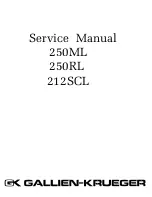
4-18
Setup
SR844 RF Lock-In Amplifier
Setup Commands
OUTX(?){i}
The
OUTX
command sets the output interface to RS232 (
i=0
) or GPIB (
i=1
).
The OUTX i command should be sent before any query commands to
direct the responses to the interface in use.
OVRM(?){i}
The
OVRM
command sets or queries the GPIB Override Remote mode. The
parameter
i
selects Off (
i=0
) or On (
i=1
).
The default mode is Override Remote On. In this mode the front panel is
always
active, regardless of the Remote or Local Lockout state. (A remote command will
always
put the SR844 into one of these states and illuminate the
REMOTE
indicator, except for
LOCL0
.)
To lock-out the front panel, use the
OVRM0
command. Then in the Remote state
only the
Local
key is active. If the unit is in Local Lockout, the entire front panel
will be disabled. To reactivate the front panel, issue
OVRM1
or
LOCL0
. In the
Remote state, pressing the
Local
key will also reactivate the front panel.
KCLK(?){i}
The
KCLK
command sets or queries the key click On (
i=1
) or Off (
i=0
) state.
ALRM(?){i}
The
ALRM
command sets or queries the alarm On (
i=1
) or Off (
i=0
) state.
SSET i
The
SSET
i
command saves the instrument setup in setting buffer
i
(
1
≤
i
≤
9
).
The setting buffers are retained when the power is turned off.
RSET i
The
RSET
i
command recalls the instrument setup from setting buffer
i
(
1
≤
i
≤
9
).
Interface parameters are not changed when a setting buffer is recalled with the
RSET
command. If setting
i
has not been saved prior to the
RSET
i
command,
then an error will result.
KNOB i
The
KNOB
i
command executes the equivalent of
i
knob adjustments. This
command is primarily provided to allow a remote program to do anything that can
be accomplished using the front panel. However, since the actions of the knob are
context sensitive, it is poor programming practice to use the
KNOB
command when
another functional command is available.
The parameter
i
is a signed integer between
-
32767 and 32767.
KEYP i
The
KEYP
command executes the equivalent of a single front panel keypress.
Although this command is primarily provided to allow the remote program to force
the reference display to show a particular quantity, such as frequency or offset, it
allows a remote program to do anything that can be accomplished using the front
panel keys. However, since the actions of the keys are context sensitive, it is poor
programming practice to use the
KEYP
command (e.g.
KEYP3
) when another
functional command (e.g.
OFSL2
) is available. The following table lists the
available keycodes.
Summary of Contents for SR844
Page 10: ...viii SR844 RF Lock In Amplifier...
Page 12: ...1 2 Getting Started SR844 RF Lock In Amplifier...
Page 32: ...2 2 SR844 Basics SR844 RF Lock In Amplifier...
Page 60: ...3 2 Operation SR844 RF Lock In Amplifier...
Page 102: ...3 44 Shift Functions SR844 RF Lock In Amplifier...
Page 108: ...4 6 Index of Commands SR844 RF Lock In Amplifier...
Page 144: ...4 42 Example Program SR844 RF Lock In Amplifier...
Page 146: ...5 2 Performance Tests SR844 RF Lock In Amplifier...
Page 150: ...5 6 Performance Tests SR844 RF Lock In Amplifier...
Page 156: ...5 12 Performance Tests SR844 RF Lock In Amplifier...
Page 158: ...5 14 Performance Tests SR844 RF Lock In Amplifier...
Page 162: ...5 18 Performance Tests SR844 RF Lock In Amplifier...
Page 166: ...5 22 SR844 Test Record SR844 RF Lock In Amplifier...
Page 168: ...6 2 Circuitry Parts Lists and Schematics SR844 RF Lock In Amplifier...
Page 246: ...Parts Lists SR844 RF Lock In Amplifier 6 80 Schematic Diagrams...
















































